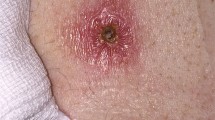Abstract
Background
Tularaemia is a zoonotic disease caused by Francisella tularensis, a highly virulent bacterium that affects humans and small wild animals. It is transmitted through direct contact with infected animals or indirectly through contaminated soil, water or arthropod bites (e.g. ticks). Primary thoracic manifestations of tularaemia are infrequent and, therefore, a diagnostic challenge for clinicians.
Methods
We report six tularaemia cases with exclusively thoracic involvement diagnosed in a clinic for pulmonary diseases in Bavaria between 10/2020 and 02/2022.
Results
All patients lived or were active in rural areas, four reported a recent tick bite. All patients presented with thoracic lymphadenopathy and pulmonary tumours or consolidations; all underwent bronchoscopy with EBUS-TBNA of lymph nodes, three lung biopsies as well. Five patients showed inflammatory changes in the endobronchial mucosa. The main histological findings were necrotic epithelioid granulomas with remarkable granulocyte infiltration. All cases were identified by positive serology, five by PCR (here identification of F.t. ssp. Holarctica) from biopsy as well. As first-line therapy, oral ciprofloxacin was given (5/6); in 2/6 cases, a combination of quinolone–rifampicin was given.
Conclusions
Pulmonary tularaemia may occur after tick bites and without extrathoracic manifestations. In patients who present with thoracic lymphadenopathy and pulmonary consolidations and who are exposed to increased outdoor activities, tularaemia should be included in the diagnostic pathway. Histologically, the presence of neutrophil–granulocyte infiltrations might help to distinguish tularaemia from other granulomatous infections, e.g. tuberculosis. The combination of quinolone–rifampicin rather than i.v. gentamicin reduced length of hospital stay in two patients.




Similar content being viewed by others
Data Availability
No datasets were generated or analysed during the current study.
References
World Health Organization. WHO guidelines on tularaemia: epidemic and pandemic alert and response. World Health Organization; 2007. (ISBN 978 92 4 154737 6).
Larson MA, et al. Differentiation of Francisella tularensis subspecies and subtypes. J clin Microbiol. 2020. https://doi.org/10.1128/JCM.01495-19.
Molins CR, et al. Virulence difference between the prototypic Schu S4 strain (A1a) and Francisella tularensis A1a, A1b, A2 and type B strains in a murine model of infection. BMC Infect Dis. 2014. https://doi.org/10.1186/1471-2334-14-67.
Rydén P, Björk R, Schäfer ML, et al. Outbreaks of tularemia in a boreal forest region depends on mosquito prevalence. J Infect Dis. 2012. https://doi.org/10.1093/infdis/jir732.
Nelson CA, Brown J, Riley L, Dennis A, Oyer R, Brown C. Lack of tularemia among health care providers with close contact with infected patients—a case series. Open Forum Infect Dis. 2019. https://doi.org/10.1093/ofid/ofz499.
Dahlstrand S, Ringertz O, Zetterberg B. Airborne tularemia in Sweden. Scand J Infect Dis. 1971. https://doi.org/10.3109/inf.1971.3.issue-1.02.
Klee SR, Jacob D, Nattermann H et al. Bioterroristisch relevante bakterielle Erreger. Bundesgesundheitsbl - Gesundheitsforsch – Gesundheitsschutz 2003; https://doi.org/10.1007/s00103-003-0724-0.
Faber M, Heuner K, Jacob D, Grunow R. Tularemia in Germany-A Re-emerging Zoonosis. Front Cell Infect Microbiol. 2018. https://doi.org/10.3389/fcimb.2018.00040.
Harik NS. Tularemia: epidemiology, diagnosis, and treatment. Pediatr Ann. 2013. https://doi.org/10.3928/00904481-20130619-13.
Feldman KA, Enscore RE, Lathrop SL, et al. An outbreak of primary pneumonic tularemia on Martha’s Vineyard. N Engl J Med. 2001. https://doi.org/10.1056/NEJMoa011374.
Chevalier K, Venon MD, Émile JF, et al. Une tularémie mimant un lymphome [A tularemia mimicking lymphoma]. Rev Med Interne. 2020. https://doi.org/10.1016/j.revmed.2020.03.008.
Kravdal A, Stubhaug ØO, Wågø AG, Steien Sætereng M, Amundsen D, Piekuviene R, Kristiansen A. Pulmonary tularaemia: a differential diagnosis to lung cancer. ERJ Open Res. 2020. https://doi.org/10.1183/23120541.00093-2019.
Kravdal A, Stubhaug ØO, Piekuviene R, Sandnes A. Pulmonary tularaemia. Tidsskr Nor Laegeforen. 2021. https://doi.org/10.4045/tidsskr.21.0245.
Martinet P, Khatchatourian L, Saidani N, et al. Hypermetabolic pulmonary lesions on FDG-PET/CT: Tularemia or neoplasia? Infect Dis Now. 2021. https://doi.org/10.1016/j.idnow.2021.06.307.
Robert Koch-Institut. RKI-Ratgeber für Ärzte Tularämie (Hasenpest). Robert Koch-Institut, Epidemiologie und Gesundheitsberichterstattung. 2016. https://doi.org/10.25646/2220.
Falldefinitionen des Robert Koch-Instituts zur Übermittlung von Erkrankungs- oder Todesfällen und Nachweisen von Krankheitserregern Ausgabe 2015 gemäß § 4 Abs. 2 des Gesetzes zur Verhütung und Bekämpfung von Infektionskrankheiten beim Menschen (Infektionsschutzgesetz – IfSG). https://www.rki.de/DE/Content/Infekt/IfSG/Falldefinition/Downloads/Falldefinitionen_des_RKI.pdf?__blob=publicationFil
Maurin M, Gyuranecz M. Tularaemia: clinical aspects in Europe. Lancet Infect Dis. 2016. https://doi.org/10.1016/S1473-3099(15)00355-2.
Kassinger SJ, van Hoek ML. Genetic determinants of antibiotic resistance in Francisella. Front Microbiol. 2021. https://doi.org/10.3389/fmicb.2021.644855.
Eliasson H, Olcén P, Sjöstedt A, Jurstrand M, Bäck E, Andersson S. Kinetics of the immune response associated with tularemia: comparison of an enzyme-linked immunosorbent assay, a tube agglutination test, and a novel whole-blood lymphocyte stimulation test. Clin Vaccine Immunol. 2008. https://doi.org/10.1128/CVI.00434-07.
Ständiger Arbeitskreis der Kompetenz- und Behandlungszentren für Krankheiten durch hochpathogene Erreger (STAKOB) am RKI. Hinweise zur Therapie der Tularämie. https://www.rki.de/DE/Content/Kommissionen/Stakob/Stellungnahmen/Stellungnahme_Tularaemie.html. Accessed 15 Oct 2021.
Caspar Y, Maurin M. Francisella tularensis susceptibility to antibiotics: a comprehensive review of the data obtained in vitro and in animal models. Front Cell Infect Microbiol. 2017. https://doi.org/10.3389/fcimb.2017.00122.
Funding
No funding was received to assist with the preparation of this article.
Author information
Authors and Affiliations
Contributions
All authors contributed to the study conception and design. Material preparation, data collection and analysis were performed by M. Vacca, M. Heiß-Neumann, B. Wilhelms and S. Zange. The first draft of the manuscript was written by M.Vacca and B. Wilhelms. All authors commented on previous versions of the manuscript. All authors read and approved the final manuscript.
Corresponding author
Ethics declarations
Conflict of interest
The authors declare that they have no competing interests.
Ethical statement
Since this was a retrospective case-series study, no ethics committee was involved.
Consent to participate and consent for publication
All patients provided written consent for the use of their data for scientific purposes and for publishing their data in a journal article.
Supplementary Information
Below is the link to the electronic supplementary material.
Rights and permissions
Springer Nature or its licensor (e.g. a society or other partner) holds exclusive rights to this article under a publishing agreement with the author(s) or other rightsholder(s); author self-archiving of the accepted manuscript version of this article is solely governed by the terms of such publishing agreement and applicable law.
About this article
Cite this article
Vacca, M., Wilhelms, B., Zange, S. et al. Thoracic manifestations of tularaemia: a case series. Infection (2024). https://doi.org/10.1007/s15010-024-02204-1
Received:
Accepted:
Published:
DOI: https://doi.org/10.1007/s15010-024-02204-1




